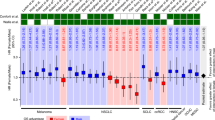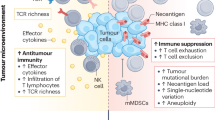Abstract
Epidemiological evidence suggests that females have an advantage over males in cases of melanoma incidence, progression, and survival. However, the biological mechanisms underlying these sex differences remain unclear. With the knowledge that females generally have a more robust immune system than males, we investigated sex differences in melanoma progression in a B16-F10/BL6 syngeneic mouse model. We observed significantly less tumor volume and growth rate over 14 days in female mice compared to male mice. Furthermore, higher populations of CD4+ and CD8+ T cells, which indicate adaptive immune responses, were found in the circulating blood and tumors of females and corresponded with less tumor growth, and vice versa in males. Our results highlight a mouse model that represents melanoma progression in the human population and displays a higher immune response to melanoma in females compared to males. These findings suggest that the immune system may be one of the mechanisms responsible for sex differences in melanoma.


Similar content being viewed by others
References
American Cancer Society Cancer facts & figures 2020. The Society, Atlanta, GA
Parkin DM, Mesher D, Sasieni P (2011) 13. Cancers attributable to solar (ultraviolet) radiation exposure in the UK in 2010. Br J Cancer 105(Suppl 2):S66–S69. https://doi.org/10.1038/bjc.2011.486
Koh HK, Bak SM, Geller AC, Mangione TW, Hingson RW, Levenson SM, Miller DR, Lew RA, Howland J (1997) Sunbathing habits and sunscreen use among white adults: results of a national survey. Am J Public Health 87(7):1214–1217. https://doi.org/10.2105/ajph.87.7.1214
Choi K, Lazovich D, Southwell B, Forster J, Rolnick SJ, Jackson J (2010) Prevalence and characteristics of indoor tanning use among men and women in the United States. Arch Dermatol 146(12):1356–1361. https://doi.org/10.1001/archdermatol.2010.355
Liu-Smith F, Farhat AM, Arce A, Ziogas A, Taylor T, Wang Z, Yourk V, Liu J, Wu J, McEligot AJ, Anton-Culver H, Meyskens FL (2017) Sex differences in the association of cutaneous melanoma incidence rates and geographic ultraviolet light exposure. J Am Acad Dermatol 76(3):499–505. https://doi.org/10.1016/j.jaad.2016.08.027
Joosse A, de Vries E, Eckel R, Nijsten T, Eggermont AM, Holzel D, Coebergh JW, Engel J, Munich Melanoma G (2011) Gender differences in melanoma survival: female patients have a decreased risk of metastasis. J Invest Dermatol 131(3):719–726. https://doi.org/10.1038/jid.2010.354
Miller AJ, Mihm MC Jr (2006) Melanoma. N Engl J Med 355(1):51–65. https://doi.org/10.1056/NEJMra052166
Ramirez-Montagut T, Turk MJ, Wolchok JD, Guevara-Patino JA, Houghton AN (2003) Immunity to melanoma: unraveling the relation of tumor immunity and autoimmunity. Oncogene 22(20):3180–3187. https://doi.org/10.1038/sj.onc.1206462
Klein SL, Flanagan KL (2016) Sex differences in immune responses. Nat Rev Immunol 16(10):626–638. https://doi.org/10.1038/nri.2016.90
Dakup PP, Porter KI, Little AA, Gajula RP, Zhang H, Skornyakov E, Kemp MG, Van Dongen HPA, Gaddameedhi S (2018) The circadian clock regulates cisplatin-induced toxicity and tumor regression in melanoma mouse and human models. Oncotarget 9(18):14524–14538. https://doi.org/10.18632/oncotarget.24539
Zhang H, Meadows GG (2005) Chronic alcohol consumption in mice increases the proportion of peripheral memory T cells by homeostatic proliferation. J Leukoc Biol 78(5):1070–1080. https://doi.org/10.1189/jlb.0605317
Liu W, Dowling JP, Murray WK, McArthur GA, Thompson JF, Wolfe R, Kelly JW (2006) Rate of growth in melanomas: characteristics and associations of rapidly growing melanomas. Arch Dermatol 142(12):1551–1558. https://doi.org/10.1001/archderm.142.12.1551
Gajewski TF, Schreiber H, Fu YX (2013) Innate and adaptive immune cells in the tumor microenvironment. Nat Immunol 14(10):1014–1022. https://doi.org/10.1038/ni.2703
Mansour M, Pohajdak B, Kast WM, Fuentes-Ortega A, Korets-Smith E, Weir GM, Brown RG, Daftarian P (2007) Therapy of established B16-F10 melanoma tumors by a single vaccination of CTL/T helper peptides in VacciMax. J Transl Med 5:20. https://doi.org/10.1186/1479-5876-5-20
Courtenay WH (2000) Constructions of masculinity and their influence on men’s well-being: a theory of gender and health. Soc Sci Med 50(10):1385–1401. https://doi.org/10.1016/s0277-9536(99)00390-1
Dronca RS, Dong H (2015) A gender factor in shaping T-cell immunity to melanoma. Front Oncol 5:8. https://doi.org/10.3389/fonc.2015.00008
Knutson KL, Disis ML (2005) Tumor antigen-specific T helper cells in cancer immunity and immunotherapy. Cancer Immunol Immunother 54(8):721–728. https://doi.org/10.1007/s00262-004-0653-2
Roberts CW, Walker W, Alexander J (2001) Sex-associated hormones and immunity to protozoan parasites. Clin Microbiol Rev 14(3):476–488. https://doi.org/10.1128/CMR.14.3.476-488.2001
Zhang MA, Rego D, Moshkova M, Kebir H, Chruscinski A, Nguyen H, Akkermann R, Stanczyk FZ, Prat A, Steinman L, Dunn SE (2012) Peroxisome proliferator-activated receptor (PPAR)alpha and -gamma regulate IFNgamma and IL-17A production by human T cells in a sex-specific way. Proc Natl Acad Sci USA 109(24):9505–9510. https://doi.org/10.1073/pnas.1118458109
Wesa AK, Mandic M, Taylor JL, Moschos S, Kirkwood JM, Kwok WW, Finke JH, Storkus WJ (2014) Circulating type-1 anti-tumor CD4(+) T cells are preferentially pro-apoptotic in cancer patients. Front Oncol 4:266. https://doi.org/10.3389/fonc.2014.00266
Gubbels Bupp MR, Potluri T, Fink AL, Klein SL (2018) The confluence of sex hormones and aging on immunity. Front Immunol 9:1269. https://doi.org/10.3389/fimmu.2018.01269
Caruntu C, Mirica A, Rosca AE, Mirica R, Caruntu A, Tampa M, Matei C, Constantin C, Neagu M, Badarau AI, Badiu C, Moraru L (2016) The role of estrogens and estrogen receptors in melanoma development and progression. Acta Endocrinol (Buchar) 12(2):234–241. https://doi.org/10.4183/aeb.2016.234
Phiel KL, Henderson RA, Adelman SJ, Elloso MM (2005) Differential estrogen receptor gene expression in human peripheral blood mononuclear cell populations. Immunol Lett 97(1):107–113. https://doi.org/10.1016/j.imlet.2004.10.007
Kovats S (2015) Estrogen receptors regulate innate immune cells and signaling pathways. Cell Immunol 294(2):63–69. https://doi.org/10.1016/j.cellimm.2015.01.018
Fox HS, Bond BL, Parslow TG (1991) Estrogen regulates the IFN-gamma promoter. J Immunol 146(12):4362–4367
Karpuzoglu E, Phillips RA, Gogal RM Jr, Ansar Ahmed S (2007) IFN-gamma-inducing transcription factor, T-bet is upregulated by estrogen in murine splenocytes: role of IL-27 but not IL-12. Mol Immunol 44(7):1808–1814. https://doi.org/10.1016/j.molimm.2006.08.005
Polanczyk MJ, Carson BD, Subramanian S, Afentoulis M, Vandenbark AA, Ziegler SF, Offner H (2004) Cutting edge: estrogen drives expansion of the CD4 + CD25 + regulatory T cell compartment. J Immunol 173(4):2227–2230. https://doi.org/10.4049/jimmunol.173.4.2227
Ishida Y, Agata Y, Shibahara K, Honjo T (1992) Induced expression of PD-1, a novel member of the immunoglobulin gene superfamily, upon programmed cell death. EMBO J 11(11):3887–3895
Lin PY, Sun L, Thibodeaux SR, Ludwig SM, Vadlamudi RK, Hurez VJ, Bahar R, Kious MJ, Livi CB, Wall SR, Chen L, Zhang B, Shin T, Curiel TJ (2010) B7-H1-dependent sex-related differences in tumor immunity and immunotherapy responses. J Immunol 185(5):2747–2753. https://doi.org/10.4049/jimmunol.1000496
Acknowledgements
This work was supported by grants from the Congressionally Directed Medical Research Program Award CA171123 (S.G.), in part by the National Institutes of Health R01ES030113, R21CA227381 (S.G.) and Melanoma Research Alliance Team Science Award (S.G.).
Author information
Authors and Affiliations
Contributions
Concept and supervision by SG. Animal studies, assays, and analysis performed by PD, KP, AL, and SG. Immunology expertise, training, and antibodies from AL and HZ. Writing of the original draft by PD. Reviewing and editing by all authors.
Corresponding author
Ethics declarations
Conflict of interest
The authors declare that they have no conflicts of interest.
Additional information
Publisher's Note
Springer Nature remains neutral with regard to jurisdictional claims in published maps and institutional affiliations.
Electronic supplementary material
Below is the link to the electronic supplementary material.
262_2020_2643_MOESM1_ESM.jpg
Fig. S1—Determination of B16-F10 tumor growth rates. A linear regression model was fit to the tumor growth data for each sex from Fig. 1 and generated the equation y = mx + b, where m = slope. The difference in the slopes was calculated using one-way ANOVA to test the null hypothesis that the slopes are identical. Supplementary material 1 (JPEG 40 kb)
Rights and permissions
About this article
Cite this article
Dakup, P.P., Porter, K.I., Little, A.A. et al. Sex differences in the association between tumor growth and T cell response in a melanoma mouse model. Cancer Immunol Immunother 69, 2157–2162 (2020). https://doi.org/10.1007/s00262-020-02643-3
Received:
Accepted:
Published:
Issue Date:
DOI: https://doi.org/10.1007/s00262-020-02643-3




